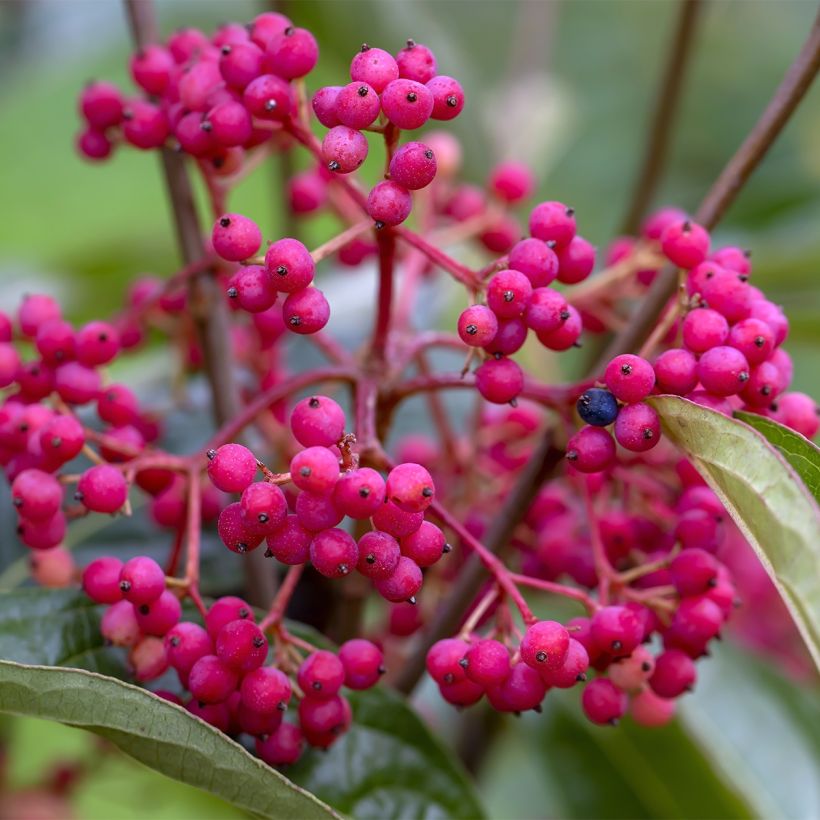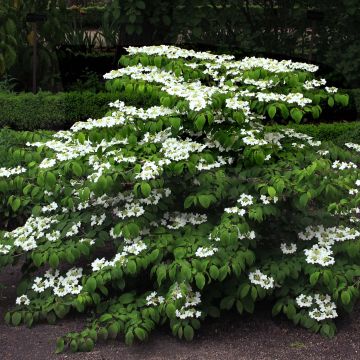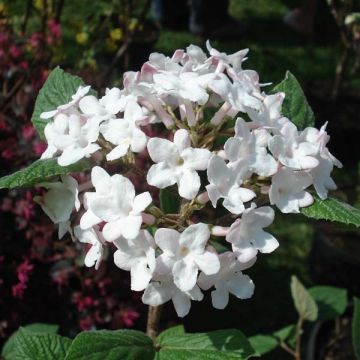

Viburnum nudum Brandywine
Viburnum nudum Brandywine
Viburnum nudum Brandywine®
Possumhaw Viburnum, Smooth Witherod, Naked Witherod
This item cannot be shipped to the selected country
Delivery charge from €5.90
More information
Schedule delivery date,
and select date in basket
This plant carries a 24 months recovery warranty
More information
We guarantee the quality of our plants for a full growing cycle, and will replace at our expense any plant that fails to recover under normal climatic and planting conditions.
From €5.90 for pickup delivery and €6.90 for home delivery
Express home delivery from €8.90.
Does this plant fit my garden?
Set up your Plantfit profile →
Description
Viburnum nudum Brandywine ('Bulk'), also known as Viburnum nudum 'Bulk', is decorative almost all year round. This bush is not only attractive for its adorable little pink and then dark blue berries that persist on the branches throughout winter, but also for its (usually) semi-evergreen foliage, which takes on splendid autumn colours. With a moderate growth rate, it is rustic, refined, and colourful, making it a lovely plant for non-calcareous garden soils that remain moist.
Viburnum nudum is native to the United States, Canada, and Saint-Pierre-et-Miquelon. It belongs to the Viburnaceae family. It is a large bush that can reach 3.5m (11ft) in all directions, growing in slightly acidic (pH 5.5 to 6.5), humus-rich soils, especially moist to wet, as it dislikes drought. In May-June, it produces fragrant white flowers in almost flat clusters. These develop into small yellow, then pink, and finally blue-violet berries. Very hardy (down to about -28°C (-18.4°F)), this viburnum thrives in full sun or partial shade.
Brandywine, introduced by Mark Bulk from Boskoop (a renowned nursery location in the Netherlands), stands out for its more compact habit than the botanical species, as well as its remarkable pink and violet fruiting. This bush will not exceed 2m (7ft) in height and spread, fitting perfectly into a rural hedge, especially as it is known to be resistant to deer. It blooms in June-July, in the form of large flat-topped corymbs, 10 to 15cm (4 to 6in) in diameter, composed of small fragrant white flowers that are highly attractive to pollinators and butterflies. The fruiting is abundant and very decorative, with clusters of numerous round berries in a vibrant pink colour, turning dark blue to almost black when ripe. Its foliage is deciduous to semi-evergreen depending on the severity of winter, and consists of large elliptical leaves of a beautiful glossy dark green. They turn red, purplish-violet, and brown in autumn.
Brandywine is perfect in a natural garden. It can be planted alone, in a border, or as part of a countryside hedge. It can be accompanied by Amelanchier lamarckii, which has magnificent spring flowering and also develops decorative fruits, as well as stunning autumn colours. Our European spindle tree, Euonymus europaeus, will not be left behind with its curious and highly decorative "bishop's hat" fruits and its flamboyant autumn colours. In the same vein, the White Snowberry will bring a white touch with its decorative fruits, while a 'Mont Rose' Deutzia will colour the spring with its lovely pink flowers.
Report an error about the product description
Viburnum nudum Brandywine in pictures






Plant habit
Flowering
Foliage
Botanical data
Viburnum
nudum
Brandywine®
Caprifoliaceae (Adoxaceae)
Possumhaw Viburnum, Smooth Witherod, Naked Witherod
Cultivar or hybrid
Other Viburnum
Planting and care
Viburnum nudum Brandywine thrives in sunny or semi-shady positions. While it prefers moist, humus-rich and light soil, it adapts to any neutral to slightly acidic garden soil, without becoming too dry. Optionally, add compost to the planting substrate, as it appreciates fertile soils. Generous watering after planting and during the first few weeks will ensure good establishment. Light pruning can be done after flowering to maintain a compact habit, but obviously at the expense of fruit production.
Planting period
Intended location
Care
This item has not been reviewed yet - be the first to leave a review about it.
Haven't found what you were looking for?
Hardiness is the lowest winter temperature a plant can endure without suffering serious damage or even dying. However, hardiness is affected by location (a sheltered area, such as a patio), protection (winter cover) and soil type (hardiness is improved by well-drained soil).

Photo Sharing Terms & Conditions
In order to encourage gardeners to interact and share their experiences, Promesse de fleurs offers various media enabling content to be uploaded onto its Site - in particular via the ‘Photo sharing’ module.
The User agrees to refrain from:
- Posting any content that is illegal, prejudicial, insulting, racist, inciteful to hatred, revisionist, contrary to public decency, that infringes on privacy or on the privacy rights of third parties, in particular the publicity rights of persons and goods, intellectual property rights, or the right to privacy.
- Submitting content on behalf of a third party;
- Impersonate the identity of a third party and/or publish any personal information about a third party;
In general, the User undertakes to refrain from any unethical behaviour.
All Content (in particular text, comments, files, images, photos, videos, creative works, etc.), which may be subject to property or intellectual property rights, image or other private rights, shall remain the property of the User, subject to the limited rights granted by the terms of the licence granted by Promesse de fleurs as stated below. Users are at liberty to publish or not to publish such Content on the Site, notably via the ‘Photo Sharing’ facility, and accept that this Content shall be made public and freely accessible, notably on the Internet.
Users further acknowledge, undertake to have ,and guarantee that they hold all necessary rights and permissions to publish such material on the Site, in particular with regard to the legislation in force pertaining to any privacy, property, intellectual property, image, or contractual rights, or rights of any other nature. By publishing such Content on the Site, Users acknowledge accepting full liability as publishers of the Content within the meaning of the law, and grant Promesse de fleurs, free of charge, an inclusive, worldwide licence for the said Content for the entire duration of its publication, including all reproduction, representation, up/downloading, displaying, performing, transmission, and storage rights.
Users also grant permission for their name to be linked to the Content and accept that this link may not always be made available.
By engaging in posting material, Users consent to their Content becoming automatically accessible on the Internet, in particular on other sites and/or blogs and/or web pages of the Promesse de fleurs site, including in particular social pages and the Promesse de fleurs catalogue.
Users may secure the removal of entrusted content free of charge by issuing a simple request via our contact form.
The flowering period indicated on our website applies to countries and regions located in USDA zone 8 (France, the United Kingdom, Ireland, the Netherlands, etc.)
It will vary according to where you live:
- In zones 9 to 10 (Italy, Spain, Greece, etc.), flowering will occur about 2 to 4 weeks earlier.
- In zones 6 to 7 (Germany, Poland, Slovenia, and lower mountainous regions), flowering will be delayed by 2 to 3 weeks.
- In zone 5 (Central Europe, Scandinavia), blooming will be delayed by 3 to 5 weeks.
In temperate climates, pruning of spring-flowering shrubs (forsythia, spireas, etc.) should be done just after flowering.
Pruning of summer-flowering shrubs (Indian Lilac, Perovskia, etc.) can be done in winter or spring.
In cold regions as well as with frost-sensitive plants, avoid pruning too early when severe frosts may still occur.
The planting period indicated on our website applies to countries and regions located in USDA zone 8 (France, United Kingdom, Ireland, Netherlands).
It will vary according to where you live:
- In Mediterranean zones (Marseille, Madrid, Milan, etc.), autumn and winter are the best planting periods.
- In continental zones (Strasbourg, Munich, Vienna, etc.), delay planting by 2 to 3 weeks in spring and bring it forward by 2 to 4 weeks in autumn.
- In mountainous regions (the Alps, Pyrenees, Carpathians, etc.), it is best to plant in late spring (May-June) or late summer (August-September).
The harvesting period indicated on our website applies to countries and regions in USDA zone 8 (France, England, Ireland, the Netherlands).
In colder areas (Scandinavia, Poland, Austria...) fruit and vegetable harvests are likely to be delayed by 3-4 weeks.
In warmer areas (Italy, Spain, Greece, etc.), harvesting will probably take place earlier, depending on weather conditions.
The sowing periods indicated on our website apply to countries and regions within USDA Zone 8 (France, UK, Ireland, Netherlands).
In colder areas (Scandinavia, Poland, Austria...), delay any outdoor sowing by 3-4 weeks, or sow under glass.
In warmer climes (Italy, Spain, Greece, etc.), bring outdoor sowing forward by a few weeks.













































